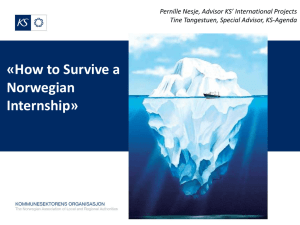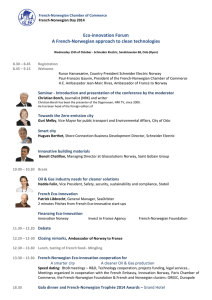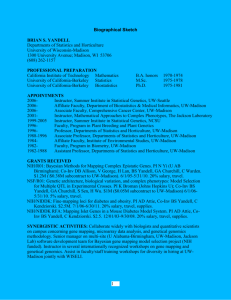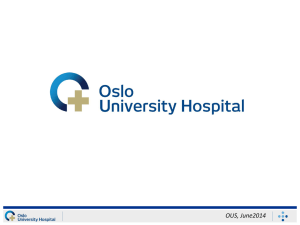PPTX - University of Wisconsin
advertisement
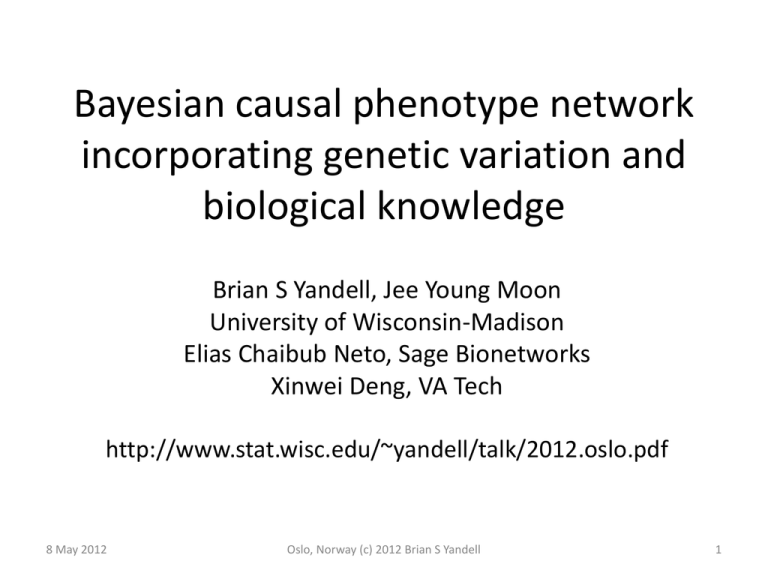
Bayesian causal phenotype network incorporating genetic variation and biological knowledge Brian S Yandell, Jee Young Moon University of Wisconsin-Madison Elias Chaibub Neto, Sage Bionetworks Xinwei Deng, VA Tech http://www.stat.wisc.edu/~yandell/talk/2012.oslo.pdf 8 May 2012 Oslo, Norway (c) 2012 Brian S Yandell 1 BTBR mouse is insulin resistant B6 is not make both obese… glucose Monsanto: Yandell © 2012 (courtesy AD Attie) Alan Attie Biochemistry insulin 2 bigger picture • how do DNA, RNA, proteins, metabolites regulate each other? • regulatory networks from microarray expression data – time series measurements or transcriptional perturbations – segregating population: genotype as driving perturbations • goal: discover causal regulatory relationships among phenotypes • use knowledge of regulatory relationships from databases – how can this improve causal network reconstruction? 8 May 2012 Oslo, Norway (c) 2012 Brian S Yandell 3 BxH ApoE-/- chr 2: hotspot x% threshold on number of traits DNAlocal genedistant genes Data: Ghazalpour et al.(2006) PLoS Genetics 8 May 2012 Oslo, Norway (c) 2012 Brian S Yandell 4 QTL-driven directed graphs • given genetic architecture (QTLs), what causal network structure is supported by data? • R/qdg available at www.github.org/byandell • references – Chaibub Neto, Ferrara, Attie, Yandell (2008) Inferring causal phenotype networks from segregating populations. Genetics 179: 1089-1100. [doi:genetics.107.085167] – Ferrara et al. Attie (2008) Genetic networks of liver metabolism revealed by integration of metabolic and transcriptomic profiling. PLoS Genet 4: e1000034. [doi:10.1371/journal.pgen.1000034] 8 May 2012 Oslo, Norway (c) 2012 Brian S Yandell 5 partial correlation (PC) skeleton correlations true graph 1st order partial correlations 8 May 2012 drop edge Oslo, Norway (c) 2012 Brian S Yandell 6 partial correlation (PC) skeleton true graph 2nd order partial correlations 8 May 2012 1st order partial correlations drop edge Oslo, Norway (c) 2012 Brian S Yandell 7 edge direction: which is causal? due to QTL 8 May 2012 Oslo, Norway (c) 2012 Brian S Yandell 8 test edge direction using LOD score 8 May 2012 Oslo, Norway (c) 2012 Brian S Yandell 9 reverse edges using QTLs true graph 8 May 2012 Oslo, Norway (c) 2012 Brian S Yandell 10 causal graphical models in systems genetics • What if genetic architecture and causal network are unknown? jointly infer both using iteration • Chaibub Neto, Keller, Attie, Yandell (2010) Causal Graphical Models in Systems Genetics: a unified framework for joint inference of causal network and genetic architecture for correlated phenotypes. Ann Appl Statist 4: 320-339. [doi:10.1214/09-AOAS288] • R/qtlnet available from www.github.org/byandell • Related references – Schadt et al. Lusis (2005 Nat Genet); Li et al. Churchill (2006 Genetics); Chen Emmert-Streib Storey(2007 Genome Bio); Liu de la Fuente Hoeschele (2008 Genetics); Winrow et al. Turek (2009 PLoS ONE); Hageman et al. Churchill (2011 Genetics) 8 May 2012 Oslo, Norway (c) 2012 Brian S Yandell 11 Basic idea of QTLnet • iterate between finding QTL and network • genetic architecture given causal network – trait y depends on parents pa(y) in network – QTL for y found conditional on pa(y) • Parents pa(y) are interacting covariates for QTL scan • causal network given genetic architecture – build (adjust) causal network given QTL – each direction change may alter neighbor edges 8 May 2012 Oslo, Norway (c) 2012 Brian S Yandell 12 missing data method: MCMC • • • • known phenotypes Y, genotypes Q unknown graph G want to study Pr(Y | G, Q) break down in terms of individual edges – Pr(Y|G,Q) = sum of Pr(Yi | pa(Yi), Q) • sample new values for individual edges – given current value of all other edges • repeat many times and average results 8 May 2012 Oslo, Norway (c) 2012 Brian S Yandell 13 MCMC steps for QTLnet • propose new causal network G – with simple changes to current network: – change edge direction – add or drop edge • find any new genetic architectures Q – update phenotypes when parents pa(y) change in new G • compute likelihood for new network and QTL – Pr(Y | G, Q) • accept or reject new network and QTL – usual Metropolis-Hastings idea 8 May 2012 Oslo, Norway (c) 2012 Brian S Yandell 14 BxH ApoE-/- causal network for transcription factor Pscdbp causal trait work of Elias Chaibub Neto Data: Ghazalpour et al.(2006) PLoS Genetics 8 May 2012 Oslo, Norway (c) 2012 Brian S Yandell 15 scaling up to larger networks • reduce complexity of graphs – use prior knowledge to constrain valid edges – restrict number of causal edges into each node • make task parallel: run on many machines – pre-compute conditional probabilities – run multiple parallel Markov chains • rethink approach – LASSO, sparse PLS, other optimization methods 8 May 2012 Oslo, Norway (c) 2012 Brian S Yandell 16 graph complexity with node parents pa1 pa1 node of1 8 May 2012 of2 pa2 pa3 node of3 of1 Oslo, Norway (c) 2012 Brian S Yandell of2 of3 17 parallel phases for larger projects 1 Phase 1: identify parents Phase 2: compute BICs 2.1 … 2.2 2.b BIC = LOD – penalty all possible parents to all nodes 3 Phase 3: store BICs 4.1 … 4.2 4.m Phase 4: run Markov chains 5 Phase 5: combine results 8 May 2012 Oslo, Norway (c) 2012 Brian S Yandell 18 parallel implementation • R/qtlnet available at www.github.org/byandell • Condor cluster: chtc.cs.wisc.edu – System Of Automated Runs (SOAR) • ~2000 cores in pool shared by many scientists • automated run of new jobs placed in project Phase 2 8 May 2012 Phase 4 Oslo, Norway (c) 2012 Brian S Yandell 19 single edge updates burnin 8 May 2012 Oslo, Norway (c) 2012 Brian S Yandell 20 100,000 runs neighborhood edge reversal select edge drop edge identify parents orphan nodes reverse edge find new parents Grzegorczyk M. and Husmeier D. (2008) Machine Learning 71 (2-3), 265-305. 8 May 2012 Oslo, Norway (c) 2012 Brian S Yandell 21 neighborhood for reversals only burnin 8 May 2012 Oslo, Norway (c) 2012 Brian S Yandell 22 100,000 runs how to use functional information? • functional grouping from prior studies – may or may not indicate direction – gene ontology (GO), KEGG – knockout (KO) panels – protein-protein interaction (PPI) database – transcription factor (TF) database • methods using only this information • priors for QTL-driven causal networks – more weight to local (cis) QTLs? 8 May 2012 Oslo, Norway (c) 2012 Brian S Yandell 23 modeling biological knowledge • infer graph GY from biological knowledge B – Pr(GY | B, W) = exp( – W * |B–GY|) / constant – B = prob of edge given TF, PPI, KO database • derived using previous experiments, papers, etc. – GY = 0-1 matrix for graph with directed edges • W = inferred weight of biological knowledge – W=0: no influence; W large: assumed correct – P(W|B) = exp(- W) exponential • Werhli and Husmeier (2007) J Bioinfo Comput Biol 8 May 2012 Oslo, Norway (c) 2012 Brian S Yandell 24 combining eQTL and bio knowledge • probability for graph G and bio-weights W – given phenotypes Y, genotypes Q, bio info B • Pr(G, W | Y, Q, B) = c Pr(Y|G,Q)Pr(G|B,W,Q)Pr(W|B) – Pr(Y|G,Q) is genetic architecture (QTLs) • using parent nodes of each trait as covariates – Pr(G|B,W,Q) = Pr(GY|B,W) Pr(GQY|Q) • Pr(GY|B,W) relates graph to biological info • Pr(GQY|Q) relates genotype to phenotype Moon JY, Chaibub Neto E, Deng X, Yandell BS (2011) Growing graphical models to infer causal phenotype networks. In Probabilistic Graphical Models Dedicated to Applications in Genetics. Sinoquet C, Mourad R, eds. (in review) 8 May 2012 Oslo, Norway (c) 2012 Brian S Yandell 25 encoding biological knowledge B transcription factors, DNA binding (causation) Bij • • • • e e p p (1 e ) p = p-value for TF binding of ij truncated exponential () when TF ij uniform if no detection relationship Bernard, Hartemink (2005) Pac Symp Biocomp 8 May 2012 Oslo, Norway (c) 2012 Brian S Yandell 26 encoding biological knowledge B protein-protein interaction (association) posteriorodds Bij Bji 1 posteriorodds • post odds = prior odds * LR • use positive and negative gold standards • Jansen et al. (2003) Science 8 May 2012 Oslo, Norway (c) 2012 Brian S Yandell 27 encoding biological knowledge B gene ontology(association) Bij Bji c mean(sim(GOi , GOj ) ) • GO = molecular function, processes of gene • sim = maximum information content across common parents of pair of genes • Lord et al. (2003) Bioinformatics 8 May 2012 Oslo, Norway (c) 2012 Brian S Yandell 28 MCMC with pathway information • sample new network G from proposal R(G*|G) – add or drop edges; switch causal direction • sample QTLs Q from proposal R(Q*|Q,Y) – e.g. Bayesian QTL mapping given pa(Y) • accept new network (G*,Q*) with probability • A = min(1, f(G,Q|G*,Q*)/ f(G*,Q*|G,Q)) – f(G,Q|G*,Q*) = Pr(Y|G*,Q*)Pr(G*|B,W,Q*)/R(G*|G)R(Q*|Q,Y) • sample W from proposal R(W*|W) • accept new weight W* with probability … 8 May 2012 Oslo, Norway (c) 2012 Brian S Yandell 29 ROC curve simulation open = QTLnet closed = phenotypes only 8 May 2012 Oslo, Norway (c) 2012 Brian S Yandell 30 integrated ROC curve 2x2: genetics pathways probability classifier ranks true > false edges = accuracy of B 8 May 2012 Oslo, Norway (c) 2012 Brian S Yandell 31 weight on biological knowledge incorrect 8 May 2012 non-informative Oslo, Norway (c) 2012 Brian S Yandell correct 32 yeast data—partial success 26 genes 36 inferred edges dashed: indirect (2) starred: direct (3) missed (39) reversed (0) Data: Brem, Kruglyak (2005) PNAS 8 May 2012 Oslo, Norway (c) 2012 Brian S Yandell 33 limits of causal inference • Computing costs already discussed • Noisy data leads to false positive causal calls – – – – Unfaithfulness assumption violated Depends on sample size and omic technology And on graph complexity (d = maximal path length ij) Profound limits • Uhler C, Raskutti G, Buhlmann P, Yu B (2012 in prep) Geometry of faithfulness assumption in causal inference. • Yang Li, Bruno M. Tesson, Gary A. Churchill, Ritsert C. Jansen (2010) Critical reasoning on causal inference in genome-wide linkage and association studies. Trends in Genetics 26: 493-498. 8 May 2012 Oslo, Norway (c) 2012 Brian S Yandell 34 sizes for reliable causal inference genome wide linkage & association Li, Tesson, Churchill, Jansen (2010) Trends in Genetics 8 May 2012 Oslo, Norway (c) 2012 Brian S Yandell 35 limits of causal inference unfaithful: false positive edges =min|cor(Yi,Yj)| =c•sqrt(dp/n) d=max degree p=# nodes n=sample size Uhler, Raskutti, Buhlmann, Yu (2012 in prep) 8 May 2012 Oslo, Norway (c) 2012 Brian S Yandell 36 Thanks! • Grant support – NIH/NIDDK 58037, 66369 – NIH/NIGMS 74244, 69430 – NCI/ICBP U54-CA149237 – NIH/R01MH090948 • Collaborators on papers and ideas – Alan Attie & Mark Keller, Biochemistry – Karl Broman, Aimee Broman, Christina Kendziorski 8 May 2012 Oslo, Norway (c) 2012 Brian S Yandell 37 BxH ApoE-/- chr 2: hotspot x% threshold on number of traits DNAlocal genedistant genes Data: Ghazalpour et al.(2006) PLoS Genetics 8 May 2012 Oslo, Norway (c) 2012 Brian S Yandell 38 causal model selection choices in context of larger, unknown network 8 May 2012 focal trait target trait causal focal trait target trait reactive focal trait target trait correlated focal trait target trait uncorrelated Oslo, Norway (c) 2012 Brian S Yandell 39 causal architecture references • • • • BIC: Schadt et al. (2005) Nature Genet CIT: Millstein et al. (2009) BMC Genet Aten et al. Horvath (2008) BMC Sys Bio CMST: Chaibub Neto et al. (2010) PhD thesis – Chaibub Neto et al. (2012) Genetics (in review) 8 May 2012 Oslo, Norway (c) 2012 Brian S Yandell 40 BxH ApoE-/- study Ghazalpour et al. (2008) PLoS Genetics 8 May 2012 Oslo, Norway (c) 2012 Brian S Yandell 41 8 May 2012 Oslo, Norway (c) 2012 Brian S Yandell 42


